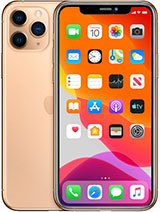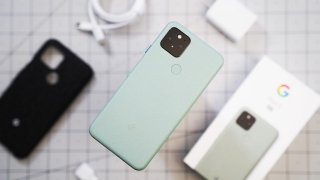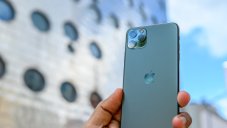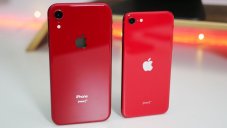Apple iPhone 11 Pro
$1183 | 106600
- 5.8" 1125x2436 pixels
- 12MP 2160p
- 4GB RAM Apple A13 Bionic
- 3046mAh Li-Ion
Phone Finder
- Acer alcatel Allview Amazon Amoi Apple Archos Asus AT&T Benefon BenQ BenQ-Siemens Bird BlackBerry Blackview BLU Bosch BQ Casio Cat Celkon Chea Coolpad Cubot Dell Doogee Emporia Energizer Ericsson Eten Fairphone Fujitsu Siemens Garmin-Asus Gigabyte Gionee Google Haier HMD Honor HP HTC Huawei i-mate i-mobile Icemobile Infinix Innostream iNQ Intex itel Jolla Karbonn Kyocera Lava LeEco Lenovo LG Maxon Maxwest Meizu Micromax Microsoft Mitac Mitsubishi Modu Motorola MWg NEC Neonode NIU Nokia Nothing Nvidia O2 OnePlus Oppo Orange Oscal Oukitel Palm Panasonic Pantech Parla Philips Plum Posh Prestigio QMobile Qtek Razer Realme Sagem Samsung Sendo Sewon Sharp Siemens Sonim Sony Sony Ericsson Spice T-Mobile TCL Tecno Tel.Me. Telit Thuraya Toshiba Ulefone Umidigi Unnecto Vertu verykool vivo VK Mobile Vodafone Wiko WND XCute Xiaomi XOLO Yezz Yota YU ZTE
Apple iPhone 11 Pro Summary
iPhone 11 Pro
iPhone 11 Pro was launched in India on September 20, 2019. Users have the choice to acquire the phone in Midnight Green, Space Grey, Silver, and Gold.
iPhone 11, 11 Pro, and 11 Pro Max all have the same main, processor, software, main, ultrawide, and front camera.
Users will be hard-pressed to choose between the iPhone 11 and its sibling, the 11 Pro as they are different in weight, price, battery, screen resolution, and size only.
If iPhone 11 is the best value for money, the 11 Pro Max is arguably the best iPhone so far.
Screen
While there is no change in the size of iPhone 11 Pro’s screen as users still have to settle for 5.8 inches, the panel has been redesigned to be much brighter with brightness stands at 800 nits with regular content.
You will notice the difference right away when watching any HDR content, which boosts the brightness to 1200 nits, according to Apple. It support for HDR10 video and Dolby Vision is most visible when viewing at full brightness. Now you can see new details in movies all while retaining the deep black on screen.
The support for Dolby Vision and HDR10 has been around since iPhone X was introduced but we are now more advantageous to enjoy this feature than we were two years ago as the library for such content has been growing in the last few years.
With a screen of 6.5 inches, iPhone 11 Pro Max may offer a more enjoyable viewing experience with Super Retina XDR display, but those who want to be able to reach every corner of their phone with one hand might prefer the iPhone 11 Pro.
While this is not the biggest screen you can get, content and games are still immersive on this phone with all of the above supports and brightness.
Chipset
The A13 Bionic chipset offers the kind of performance Android phones cannot keep up with. Users of iPhone 11 Pro report of faster video editing and exporting with the phone.
There is a slowdown when opening the camera app; however, that is probably the fault of iOS 13 than the performance of the chipset. The Geekbench 5 tests proves that the phone is the fastest around with a score of 3431.
RAM
Under the hood, along with the A13 Bionic chip are 64GB of onboard storage and 4GB of RAM, similar to iPhone 11. Overall, everything happens quickly and there are no problems with tasks like playing games or video editing.
However, the 64GB of storage í a little disappointing, especially when you prefer shooting 4K videos. Even without any of such video, apps, games, and movies will soon occupy the whole storage.
You are right to expect at least 6GB of RAM on the phone of this price but unfortunately, what you have is only 4GB. While the iPhone 11 Pro can handle everything, from video editing to gaming, many users may expect more RAM to rest assured that their handset is future-proof.
Battery
iPhone 11 Pro’s battery is durable, plenty able to sustain an average user more than a day. With heavy usage, some users might still get a day and a half. If you want even more time from one charge, iOS 13’s low-power mode can extend that time even more.
According to Apple. iPhone 11 Pro’s battery is four hours more durable than that of iPhone XS.
Last year, the iPhone XS Max is the one with longer battery life since its bigger size means Apple is able to squeeze in a larger battery. However, this time, the company has sacrificed the 3D Touch to make way for that power cell, so battery life on iPhone 11 Pro can rival any of its predecessors.
To sweeten the deal, this phone comes with lightning-to-USB-C cable and 18W charger, which means you can expect half of the battery being filled in half an hour.
On the other hand, 7.5W is what you will have to settle when wirelessly charge the phone. And reverse charging has never made it to the iPhone 11 lineup so we may have to wait for iPhone 12 to see this feature.
Camera
On the rear, the camera setup features 2x optical zoom as well as ultra-wide snapper, the first ever on an iPhone. Overall, iPhone 11’s cameras are highly versatile for almost any needs.
What we have with iPhone 11 Pro is the results expected when you use a mirrorless camera with different lenses.
Pictures have better HDR and details which normally went lost in too bright light or too low light. This effect can be found on portrait pictures too with sharper and brighter subjects.
While most Android phones out there are designed to shoot for Instagram with saturated and cooler pics, iPhone 11 Pro still offers warmer and more realistic tones.
With the front camera, you can also expect HDR in effect here. The selfie snapper now packs 12MP, a boost from 7MP, which allows for a slew of details. However, users will have to tone down the too warm tone of the camera sometimes, but that is far from a deal breaker.
After some time of waiting, Apple has finally given us 4K/60fps for the front camera. That is not all. Now you can record slow-motion video with the selfie camera as well, which Apple invented a name for it, called Slofies.
While this isn’t a breakthrough in tech or anything, that name is certainly good for marketing as after Apple made it public, the Internet was filled with memes teasing it.
If you have time for it, playing around with 120fps at 1080p can be very enjoyable. The main camera even offers 240FPS at 1080p.
Frames per second aside, there are two features that can contribute greatly to how good your videos turn out, which are Audio Zoom, which makes the microphone to focus on the subject, creating the feeling that the audio zooms in along with the camera; and cinematic video stabilization to keep everything smooth.
Apple iPhone 11 Pro Full Specifications
- Dollas $1183 Buy in Flipkart >
- Rupee ₹106600 Buy in Flipkart >
- Technology GSM / CDMA / HSPA / EVDO / LTE
- 2G bands GSM 850 / 900 / 1800 / 1900
- 1, 2, 3, 4, 5, 7, 8, 12, 13, 14, 17, 18, 19, 20, 25, 26, 29, 30, 34, 38, 39, 40, 41, 42, 46, 48, 66, 71 - A2217
- 3G bands HSDPA 850 / 900 / 1700(AWS) / 1900 / 2100
- 4G bands 1, 2, 3, 4, 5, 7, 8, 11, 12, 13, 17, 18, 19, 20, 21, 25, 26, 28, 29, 30, 32, 34, 38, 39, 40, 41, 42, 46, 48, 66 - A2215
- Speed HSPA 42.2/5.76 Mbps, LTE-A 1.6 Gbps DL, EV-DO Rev.A 3.1 Mbps
- Announced 2019, September 10
- Status Available. Released 2019, September 20
- Dimensions 144 x 71.4 x 8.1 mm (5.67 x 2.81 x 0.32 in)
- Weight 188 g (6.63 oz)
- Build Glass front (Gorilla Glass), glass back (Gorilla Glass), stainless steel frame
- SIM Nano-SIM and/or eSIM
- IP68 dust/water resistant (up to 4m for 30 mins) Apple Pay (Visa, MasterCard, AMEX certified)
- Type Super Retina XDR OLED capacitive touchscreen, 16M colors
- Size 5.8 inches, 84.4 cm2 (~82.1% screen-to-body ratio)
- Resolution 1125 x 2436 pixels, 19.5:9 ratio (~458 ppi density)
- Protection Scratch-resistant glass, oleophobic coating
- 800 nits max brightness (advertised) Dolby Vision HDR10 Wide color gamut True-tone 120Hz touch-sensing
- OS iOS 13, upgradable to iOS 13.4
- Chipset Apple A13 Bionic (7 nm+)
- CPU Hexa-core (2x2.65 GHz Lightning + 4x1.8 GHz Thunder)
- GPU Apple GPU (4-core graphics)
- Card slot No
- Internal 64GB 4GB RAM, 256GB 4GB RAM, 512GB 4GB RAM
- NVMe
- Modules 12 MP, f/1.8, 26mm (wide), 1/2.55", 1.4µm, dual pixel PDAF, OIS 12 MP, f/2.0, 52mm (telephoto), 1/3.4", 1.0µm, PDAF, OIS, 2x optical zoom 12 MP, f/2.4, 13mm (ultrawide)
- Features Quad-LED dual-tone flash, HDR (photo/panorama)
- Video 2160p@24/30/60fps, 1080p@30/60/120/240fps, HDR, stereo sound rec.
- Modules 12 MP, f/2.2, 23mm (wide) SL 3D, (depth/biometrics sensor)
- Features HDR
- Video 2160p@24/30/60fps, 1080p@30/60/120fps, gyro-EIS
- Loudspeaker Yes, with stereo speakers
- 3.5mm jack No
- WLAN Wi-Fi 802.11 a/b/g/n/ac/ax, dual-band, hotspot
- Bluetooth 5.0, A2DP, LE
- GPS Yes, with A-GPS, GLONASS, GALILEO, QZSS
- NFC Yes
- Radio No
- USB 2.0, proprietary reversible connector
- Sensors Face ID, accelerometer, gyro, proximity, compass, barometer
- Siri natural language commands and dictation
- Non-removable Li-Ion 3046 mAh battery (11.67 Wh)
- Charging Fast charging 18W, 50% in 30 min (advertised) USB Power Delivery 2.0 Qi wireless charging
- Talk time Up to 18 h (multimedia)
- Music play Up to 65 h
- Colors Space Gray, Silver, Gold, Midnight Green (matte colors)
- Models A2215, A2160, A2217
- SAR 1.18 W/kg (head) 1.16 W/kg (body)
- SAR EU 0.99 W/kg (head) 0.99 W/kg (body)
- Performance AnTuTu: 460784 (v7) GeekBench: 13829 (v4.4) GFXBench: 57fps (ES 3.1 onscreen)
- Display Contrast ratio: Infinite (nominal)
- Camera Photo
- Loudspeaker -24.3 LUFS (Very good)
- Audio quality Noise -94.2dB / Crosstalk -81.0dB
- Battery life Endurance rating 86h
Apple iPhone 11 Pro News

Mobile - Mar 10, 2021
Best Phone Camera 2020: Best Camera Phones For Indian Users

Mobile - Feb 04, 2021
Apple Starts Selling Refurbished iPhone 11, 11 Pro, And 11 Pro Max

Mobile - Oct 14, 2020
Apple Discontinues iPhone 11 Pro And Pro Max Only After One Year

Mobile - Oct 07, 2020
Best iPhone 2020: The 5 Best Models To Buy Before The iPhone 12 Comes Out

Mobile - Jul 23, 2020







